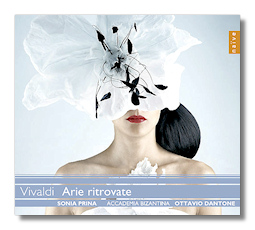
The Internet's Premier Classical Music Source
Related Links
- Vivaldi Reviews
- Latest Reviews
- More Reviews
-
By Composer
-
Collections
DVD & Blu-ray
Books
Concert Reviews
Articles/Interviews
Software
Audio
Search Amazon
Recommended Links
Site News
 CD Review
CD Review
Antonio Vivaldi

Arie ritrovate
- La Ninfa infelice e fortunata: Sarai qual padre mio
- La Silvia, RV 734: Abbia respiro il cor
- L'odio vinto dalla constanza, RV Anh 51: Perché lacerò il foglio
- La verità in cimento, RV 739: Se vincer non si può; Mi vuoi tradir lo so
- Scanderbeg e Ormondo, RV 732: Con palme ed allori; S'a voi penso, o luci belle
- Il Teuzzone, RV 736: Per lacerarlo; Vedi la mia catene; Alma mia fra tanti affanni
- Tito Manlio, RV 738: Tu dormi in tante pene
- Orlando Furioso, RV anh 84: Porta il sol del tuo sembiante
- Concerto for Strings in F Major, RV 136
- Violin Concerto in B Flat Major, RV 369
Sonia Prina, alto
Stefano Molinari, violin
Ottavio Dantone, harpsichord
Accademia Bizantina/Ottavio Dantone
Naïve OP30443 DDD 70:28
This is an enjoyable collection of Vivaldian odds and ends. As the holdings of the National University Library of Turin continue to be explored, small and large discoveries are made. Among the former, at least in size, are alternative arias from extant operas, and isolated arias belonging to operas now otherwise lost. A third type is comprised of arias from operas (or "serenatas") put together by other hands from the works of various composers, not just Vivaldi. Sometimes new words were fitted to older music; musical detective work has made it possible to reconstruct these arias from their texts even when the music is no longer extant.
Scanderbeg e Ormondo, written in 1718, no longer exists except for the two arias recorded here. Teuzzone, La verità in cimento, Tito Manlio, and Orlando Furioso have been preserved (and all recorded in toto), but the arias presented here are alternative arias – stuck between the pages, if you will – that have not been heard in three centuries. The Concerto for strings, RV 136, has been included because of the thematic relationship between its middle movement and the reconstructed aria Abbia respiro il cor.
What will matter to most people, though, is whether or not this CD stands on its own, and it does, thanks in no small part to the contributions of alto Sonia Prina. I first noticed Prina in a wacky production from the Théâtre du Châtelet of Rossini's La Pietra del Paragone, issued on DVD by Naïve. Prina's Imogene Coca-like stage presence was married to a warm, chocolatey voice that, despite its dark colors, was both agile and feminine. It's only natural, then, that she should be a specialist in the Baroque repertoire, and this CD shows just how much she has to offer. It can be hard to put across a collection of unconnected arias, but Prina's vocal personality allows her to succeed where others have failed, and the voice itself is flexible and delicious. Stefano Montanari is no less virtuosic in the witty, extraverted violin concerto that has been inserted in the middle of this program. The microphones pick up his noisy breathing, though – was it allergy season in Ravenna?
Dantone and the Accademia Bizantina, frequent participants in this ongoing Vivaldi Edition from Naïve, accompany with personality and sensitivity. As a matter of fact, Dantone, with Frédéric Delaméa (who wrote the excellent booklet notes), is responsible for the three reconstructions. Texts and translations have been included. The engineering is clear and very intimate.
Copyright © 2008, Raymond Tuttle




















